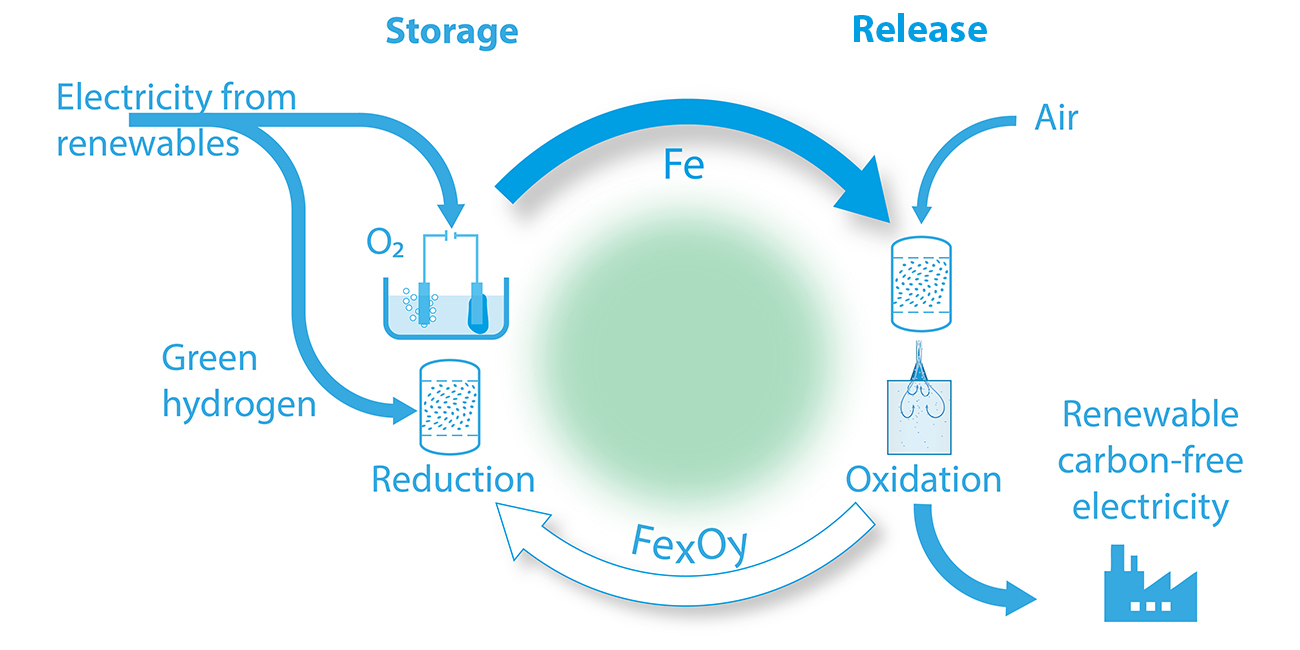Clean Circles
On the “Clean Circles – Iron is the new coal” project at TU Darmstadt, Germany, a presentation can be found here in English and German:
Clean Circles EN / Clean Circles DE
“Clean Circles” in its main variant briefly summarized:
- Green hydrogen is produced from renewable energies.
- The green hydrogen is used to remove oxygen from oxidized (“rusted”) iron dust, producing water vapor:
Fe2O3 + 3H2 => 2Fe + 3H2O - The chemically reduced iron dust serves as an energy source.
- The combustion/oxidation of iron dust produces high temperatures:
4Fe + 3O2 => 2Fe2O3 + heat
This combustion process does not produce CO2. - The now oxidized (“rusted”) iron dust is collected and completely reused in a closed circuit.
“Clean Circles” has the following advantages in particular:
- Burning iron provides a dispatchable and renewable energy source that solves the problem of fluctuating energy production from PV and wind.
- The huge potential of solar energy in sunbelt regions can be used as a renewable energy source to produce reduced iron dust: PV during the day and CSP with thermal storage at night.
- The water as the starting product to produce green hydrogen remains at the site where the reduced iron is produced and can be used there again to produce green hydrogen. This solves the problem of the large amounts of distilled water required to produce green hydrogen.
- The reduced iron dust can be transported safely pressureless at ambient temperature and has an energy density that is many times higher than that of hydrogen. This solves the problem of transporting very large amounts of green energy worldwide.
- The energy source iron can be traded and transported globally. This results in less dependency on individual suppliers than is inevitably the case with pipelines or power lines.
- The reduced iron dust can be burned at high temperatures in coal-fired power plants and in industrial plants, which only need to be adapted in some components. This makes it possible to continue to use existing infrastructure worldwide for future green energy and power generation, which can result in social and financial benefits.
- No special metallic materials are used to store energy in iron, where there is a risk of a shortage and therefore significant increases in price, such as with lithium, cobalt, and copper for batteries.
The above-mentioned set of slides contains information on the levelized cost of electricity of iron as an energy source in comparison to electricity generation with hydrogen and in comparison to the combustion of coal and gas with different taxation of CO2 emissions.
The “Clean Circles” project is not a sure-fire success. It can use active support at all levels: political, economic, technical, and social.
“Clean Circles” website: English / German
“Clean Circles” contact information: English / German
See also:
- hr „alles Wissen“ 30.11.2023: Klima und Energie: Strom in Eisen speichern
- Vortrag Prof. Dr. Andreas Dreizler: Clean Circles – Eisen als Energieträger
- Breaking Lab: Energiespeicher-Revolution: Chemische Speicherung mit Eisen
- Niklas Kolorz: Energie-Speicher der Zukunft: Ist Eisen die neue Kohle?
- AMBARTEC HyCS-Technology: Energy and Hydrogen Storage
- Eindhoven University of Technology: SOLID – A compact and clean fuel

